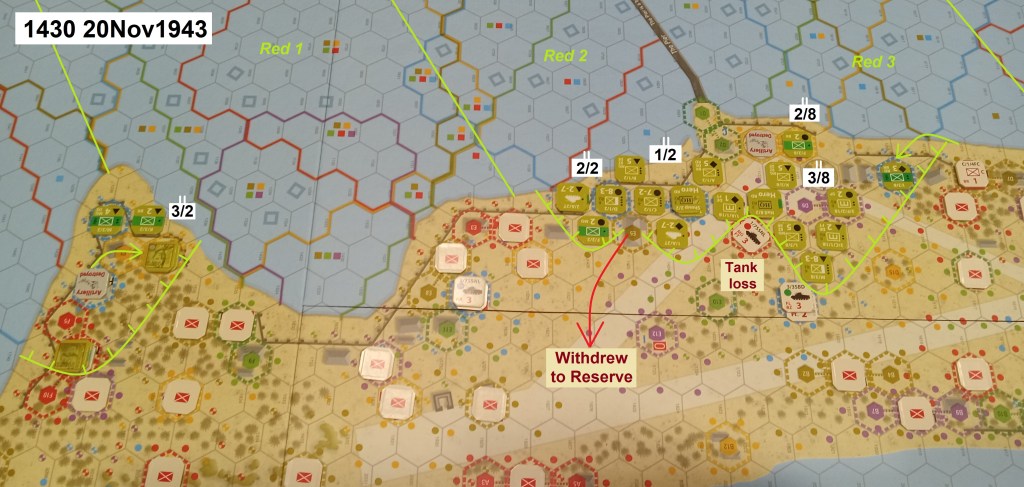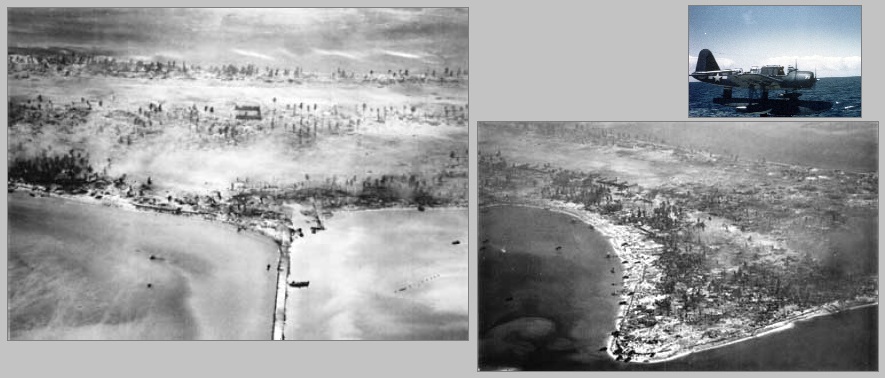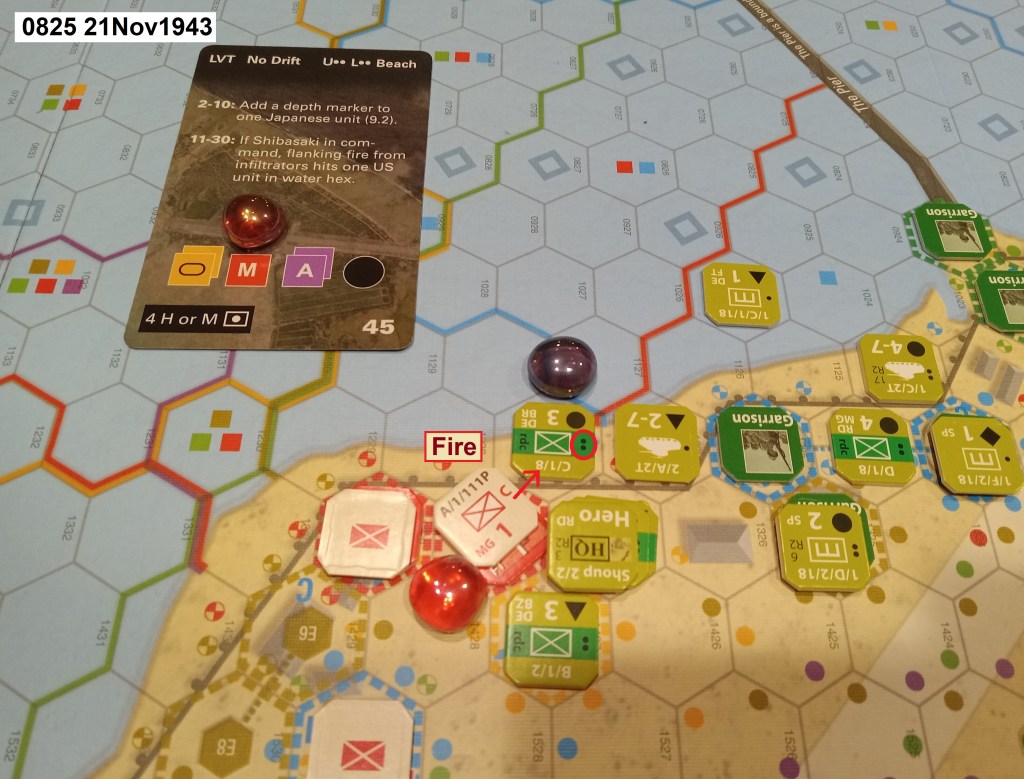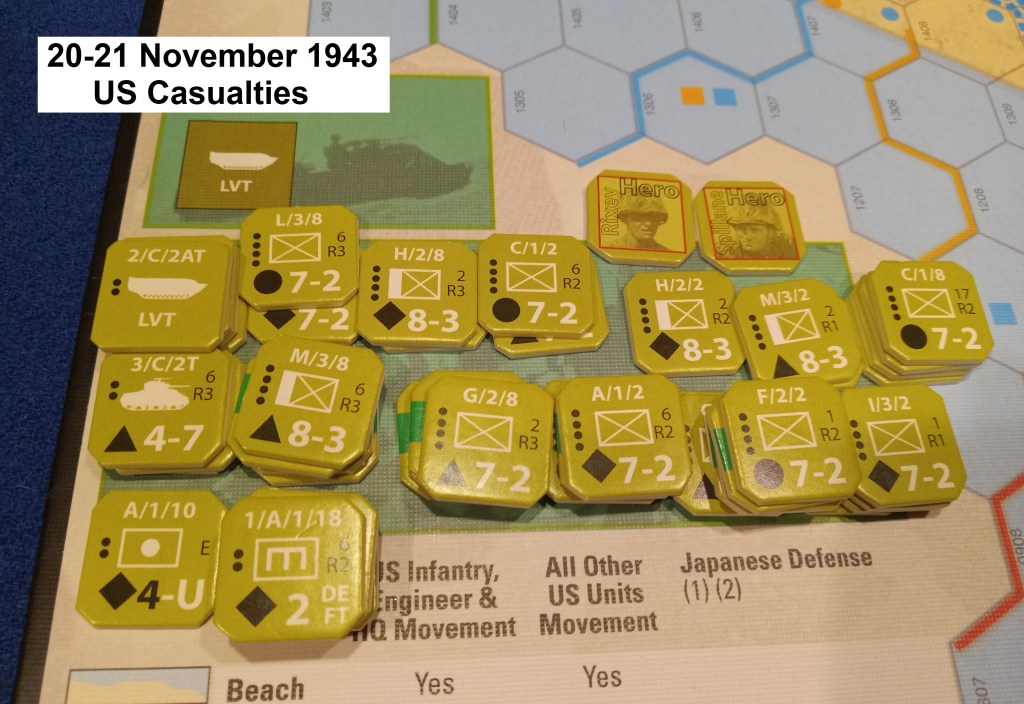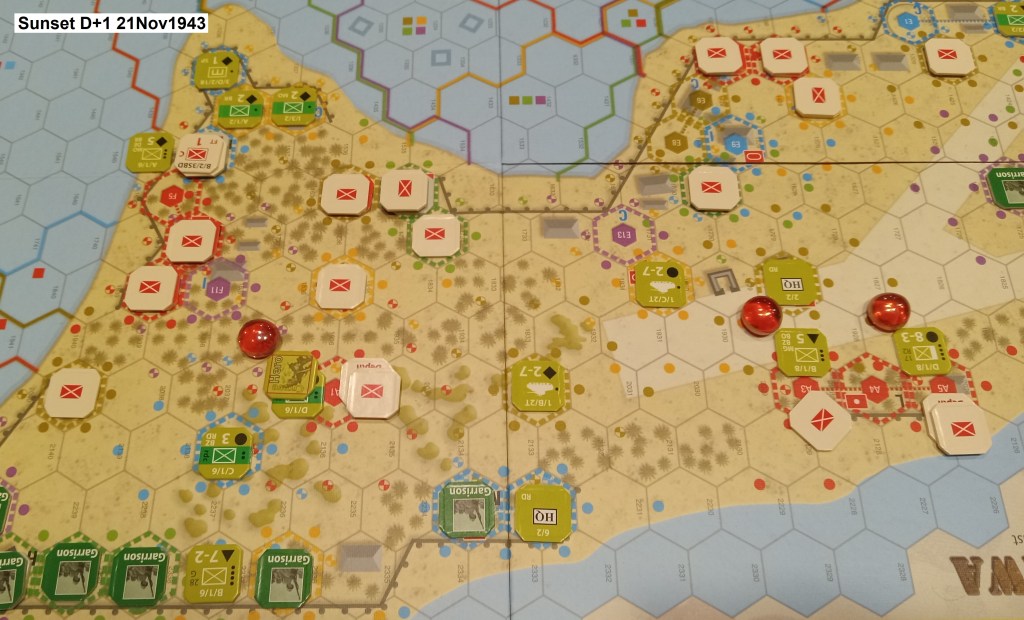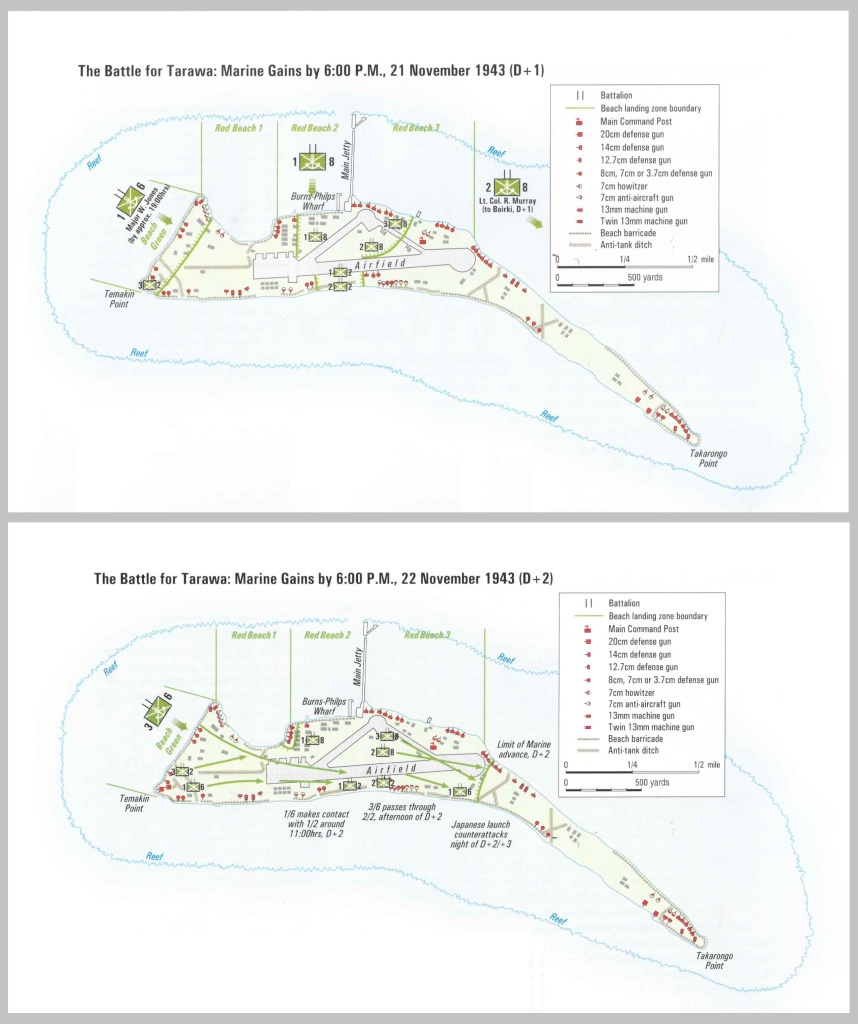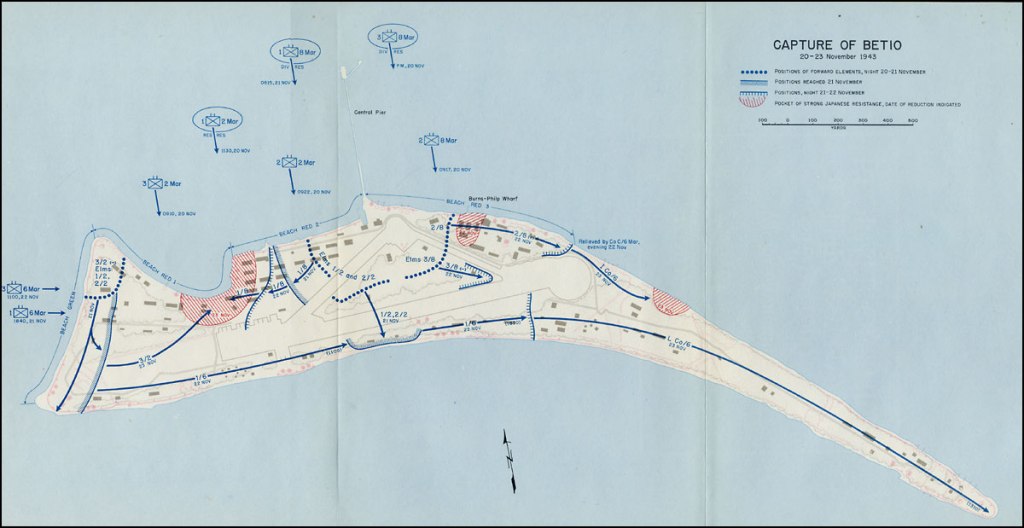You can find the first part of this session report here: D-Day at Tarawa – Replay by Volko Ruhnke, Part 1. Enjoy!
D-Day at Tarawa articles: D-Day at Tarawa – Review D-Day at Tarawa – “The First Waves” scenario D-Day at Tarawa – “The 20 November 1943” scenario D-Day at Tarawa – “The 21 November 1943” scenario
We left the Marines in Part 1 just after noon on D-Day seizing a key Japanese position across the taxiway from Red Beach 3 and looking for a breakthrough. But the enemy is not just going to sit and wait for that to happen. …
The Triangle
Almost as soon as the Marines started to encroach on the airfield, the Japanese began to move against them with infantry and, especially, tanks. Below, elite SNLF engineers—shortly after beating back Red 2 invaders—receive reinforcement (by event) and counter-assault the Americans.
(The brown double “A” on the card means that Inland positions—like that occupied by the Japanese engineers, non-adjacent to beach—will Assault, but only if there are at least two counters in the position, in this case, a unit plus a Depth marker. Coastal positions instead fire Artillery. Empty positions Ambush. You get the idea. … “Assault” means the unit moves to Close Combat the closest, weakest US unit—here, F Company of 2nd Bn/2nd Marines.)
Nearby within the triangle of the airfield, Japanese tank units fire furiously at the approaching Marines and even advance to block a breakthrough (occupying the blue D17 position to the east as the Americans come near).
The good news for the Marines is that the Japanese troops’ aggressiveness—while causing US losses—often also exposes them to US counterattack. Below, the SNLF engineers traded losses with Company F and pulled back, then get overwhelmed by the follow-on US attack. As elites, and the American units too weak to surround them, they are able to withdraw into the Japanese reserve, likely to reappear later in the day’s battle.
On the western Bird’s Beak, Ryan’s Red 1 forces have advanced to destroy the second enemy artillery position. Ryan adjusts his defensive line to better meet any similar enemy aggressiveness as Red 2 and 3 have faced.
Off Tarawa Atoll, a US battleship or cruiser launches a floatplane to observe the battle. Just after 2pm, the plane flies west along the north shore of Betio to snap the shots below (south is up). In the lefthand photo of Red 3 and Red 2, you can make out the open areas of the taxi-and-runway triangle. On the right, at this moment, Ryan’s Marines hold the near ground of the picture and are pressing their raid on Green Beach just off the camera frame’s right edge.
The Runway
Inland of Red 2 and 3, the courageous and aggressive Japanese tactics are bleeding the Marines badly. But they also are opening the way forward for the Americans.
Left: The Japanese, down to one unit of tanks within the triangle, charge right at 8th Marines’ HQ. (For tanks, “R” = Overrun; the tanks Fire and, if they hit, immediately enter Close Combat with their target.)
Right: Defenders at the HQ manage barely to beat back the onslaught of armor. Now flanked, the Type 95 light tanks soon succumb to bazookas, naval gunfire, and flamethrower teams that US engineers bring up from the beach. (Event cards provide Naval Gunfire markers. Engineer units marked “SP” from mid-afternoon of D-Day onward, when not under fire, provide Support markers—blue bead here—that can add a missing weapon type to an Attack, Garrison a secure Position, or activate units.)
A surviving US Sherman exploits the gap and races across the runway to the narrow island’s south shore—breakthrough!
Nearby, Colonel Shoup—commander of 2nd Marines/2nd Division and senior US officer ashore—sets up a more efficient, stationary command post just across the seawall from Red Beach 2. (HQ units out of direct enemy fire range beginning 2pm can become CPs—they give up movement and Hero abilities to command units at gradually increasing range.)
Now dominating the triangle, the Marines secure their hold on the island center and send infantry south across the runway to confront Japanese positions along the south beach.
But in the west, the Japanese reinforce northward against Ryan’s now shrinking beachhead on Red 1. Fortunately for US prospects, the Americans have already destroyed the artillery there, and the movement pulls Japanese defenders off Green Beach.
Sometime in the afternoon, somewhere on Betio, the commander of Japan’s Gilbert Island fortresses, Admiral Shibasaki falls to a US naval shell or Marine bullet.
The Sunset
The lucky shot on the IJN admiral (a game Event) proves a godsend to the Americans as they brace against the expected Japanese nighttime assault. Shibasaki, apparently, was to launch at least two major counterattacks, one upon nightfall and another at sunrise. But his death scotches them.
(The two Events that I drew for turn 15 were both “counterattacks” contingent on Shibasaki’s survival. Each would have activated all Japanese Positions for “A” lettered orders.)
With nightfall, it is time to account for the day’s gains. Comparing the board situation to a contemporary historical map’s US sunset positions in blue, we see that the Marines have done quite well advancing off Red 2 and 3, but gotten squeezed at Red 1. The placement of 2nd Marines command post is nearly identical just inside the Red 2 seawall.
(The game requires Securing—occupying with US units or Garrisons, and cancelling all Intense fields of fire into those hexes with US occupation of the potential fire origins—at least 12 Positions by the Night turn. I have Secured 18, shown below with blue beads, so well ahead of schedule so far. Securing 20 Position hexes that included three along the south beach would have yielded an immediate victory.)
The Dawn
The night is mostly quiet. As historically, either Shibasaki’s death or the fact that US naval bombardment succeeded in cutting Japanese telephone lines laid across the surface of the island, prevent any organized counterattack. (In the game, the Japanese get two Fire phases during the Night turn—but only if Shibasaki remains in command.)
Sunrise brings the main Marine beachhead a fresh landing team, 1st Battalion of the 8th Marines, who have been waiting in their boats all night beyond the reef. Historically, this unit took severe casualties as it waded in, with Japanese fire on the lagoon undiminished and made even more deadly by flanking fire from snipers who had occupied a shipwreck and US wrecks out in the water during the night. Here, with a reasonable number of LVT’s left, the unit’s survivors at least get to the beach quickly. They even bring with them the first intact unit of American tanks.
However, the Japanese have been far from idle overnight. They have reorganized to add some of their eliminated units to their reserves, available to reinforce vacant frontline positions (via “R” Reinforce, “M” Muster, and “I” Infiltrate actions and Tunnel Events). And frontline Marines have lost contact with opposing units in the dark (flipping revealed Japanese to hidden, making them both more dangerous and harder to disrupt or destroy.)
The Perimeter
Japanese infantry immediately reinforces the runway area along the south and re-positions (“R” Redeploy action) to mass counterattack forces along Red 2’s west flank.
Within little more than an hour of the morning’s amphibious landing, the Japanese fortress garrison’s remaining tank unit drives straight at Shoup’s headquarters (which I had already reconverted from a CP that cannot command units when under fire). Shoup manages to withdraw back to the sands of Red Beach. But his freshest force of Marines is now under extreme pressure.
Meanwhile, Japanese reserves use a pre-constructed tunnel under the runway to overwhelm a Marine garrison, putting the previously secured airfield triangle into jeopardy.
Shoup directs an attack that knocks out the last Japanese tanks and presses his western flank outward. But that local success cannot hide the fact that the US invasion has stalled out. Japanese infantry return-fire on Shoup’s beach rake the last fresh Marine infantry. Japanese artillery trained on the shoreline next takes out some of the just-landed Shermans.
(Above, circle card hits circle unit even behind the seawall. In the game, reduction of the last 3-step US infantry unit to 2 steps constitutes Catastrophic Loss and an immediate defeat for the player.)
Off-shore, US commanders have heard enough. They scrub the invasion and order evacuation of Tarawa.
Historically, the US situation on the evening of D-Day appeared so precarious that Admiral Spruance’s staff began drafting plans for emergency evacuation of the landing force. Here, given the US shock at the casualties suffered even in victory, we can only imagine the effect on the United States of such a defeat in the Central Pacific.
(Even without the Catastrophic Loss, I have no chance for victory: my forces are so weakened that my perimeter is collapsing—compare the front lines below at 0830 to those at 0615 above. The purple boxes on the Japanese fire card above would even result in the key loss of a step from the only fresh US tank unit, at right center. This invasion is over.)
The Graveyard
It is clear in retrospect that commanders asked too much of the Marines on D-Day. There was no need to take the risks and accept the attrition needed to clear the airfield triangle until the beachhead became more secure. US casualties suffered meant that the ground won only had to be given up on D+1.
US forces in the Pacific would now have to mourn their dead, study the lessons of Tarawa, and painfully try again.
The Rerun
For me, happily, I can just reset the scenario for another go.
This time, I would not just try to conquer the island but instead take the game’s specific victory conditions into account to preserve forces on D-Day for a breakout on D+1. To this end, I found advice on BoardgameGeek from PFGamer here and here singularly helpful.
This time, I achieved more modest gains on D-Day—along historical lines—while retaining the punch to breakout on D+1, once the Japanese had exhausted their reserves. The game came down to three final close combat engagements for possession of “zone A” along the southwest shore.
The mission in the game’s full two-day scenario is to secure by sunset on D+1 all positions in at least three zones—of which one zone must be either A or F—plus at least eight additional positions. Below, I have illustrated the zones. (Note that the orientation here is from the player’s view: south is up.)
Through many amazing twists and turns my second play, I did get lucky to receive Green Beach reinforcements early by event. The Japanese did run out of reserve units, and the race was on, after securing zones D and B, to grab zone A from east and west.
Against the odds, a Green Beach Hero won his close combat (left), while only one of the two Red Beach units reducing the Japanese pocket along the runway won theirs. (Both would have, had I properly used available naval shelling to disrupt the defenders.) Regardless, position hex A4 along the runway would remain unsecured: I missed winning the scenario by only a hair.
As the maps below from the game’s accompanying historical article show, the designer is asking us to beat the Marines’ historical feat by half a day. The two-day victory conditions more resemble the conquests that the American invasion achieved on the morning of D+2, not the evening of D+1.
So, John Butterfield is either telling us that the halting gains of first two days at Tarawa constituted a US defeat. Or, he expects players—who after all get to practice, study, and learn how to perform better on repeat plays—to outperform their real-life counterparts doing it all on Betio for the first and only time.
If you want to supplement the historical materials that come with D-Day at Tarawa, here is a more detailed history of the battle from the US National Park Service.
Finally, below is a single reference map from the US Army. You can use it as another handy reference to track your Marines’ progress day by day across the island.
(US Army units on the same D-Day as at Tarawa invaded Makin Atoll further north, landing on Butaritari Island—a battle that, incidentally, you can explore in the excellent Combat Commander Pacific scenario “West Tank Barrier”, sampled in Michal’s article here.)
See you across the reef! – Volko



